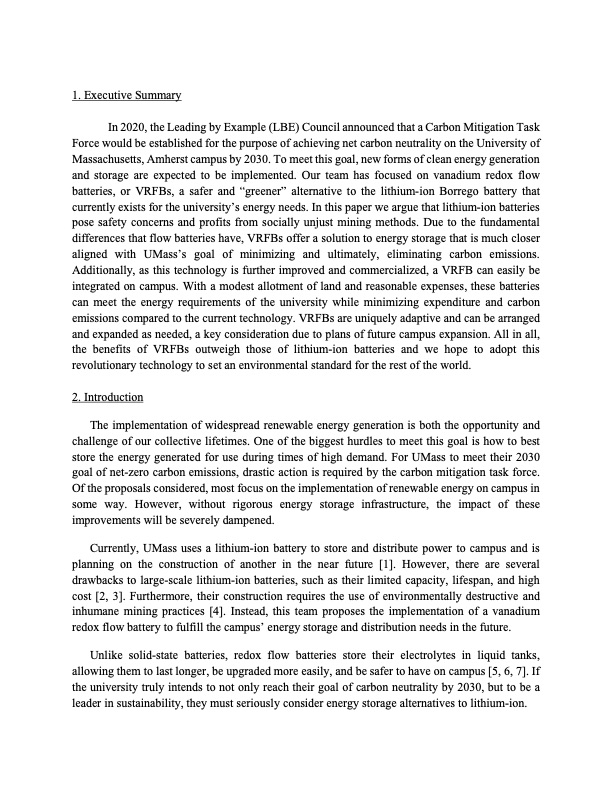
PDF Publication Title:
Text from PDF Page: 002
1. Executive Summary In 2020, the Leading by Example (LBE) Council announced that a Carbon Mitigation Task Force would be established for the purpose of achieving net carbon neutrality on the University of Massachusetts, Amherst campus by 2030. To meet this goal, new forms of clean energy generation and storage are expected to be implemented. Our team has focused on vanadium redox flow batteries, or VRFBs, a safer and “greener” alternative to the lithium-ion Borrego battery that currently exists for the university’s energy needs. In this paper we argue that lithium-ion batteries pose safety concerns and profits from socially unjust mining methods. Due to the fundamental differences that flow batteries have, VRFBs offer a solution to energy storage that is much closer aligned with UMass’s goal of minimizing and ultimately, eliminating carbon emissions. Additionally, as this technology is further improved and commercialized, a VRFB can easily be integrated on campus. With a modest allotment of land and reasonable expenses, these batteries can meet the energy requirements of the university while minimizing expenditure and carbon emissions compared to the current technology. VRFBs are uniquely adaptive and can be arranged and expanded as needed, a key consideration due to plans of future campus expansion. All in all, the benefits of VRFBs outweigh those of lithium-ion batteries and we hope to adopt this revolutionary technology to set an environmental standard for the rest of the world. 2. Introduction The implementation of widespread renewable energy generation is both the opportunity and challenge of our collective lifetimes. One of the biggest hurdles to meet this goal is how to best store the energy generated for use during times of high demand. For UMass to meet their 2030 goal of net-zero carbon emissions, drastic action is required by the carbon mitigation task force. Of the proposals considered, most focus on the implementation of renewable energy on campus in some way. However, without rigorous energy storage infrastructure, the impact of these improvements will be severely dampened. Currently, UMass uses a lithium-ion battery to store and distribute power to campus and is planning on the construction of another in the near future [1]. However, there are several drawbacks to large-scale lithium-ion batteries, such as their limited capacity, lifespan, and high cost [2, 3]. Furthermore, their construction requires the use of environmentally destructive and inhumane mining practices [4]. Instead, this team proposes the implementation of a vanadium redox flow battery to fulfill the campus’ energy storage and distribution needs in the future. Unlike solid-state batteries, redox flow batteries store their electrolytes in liquid tanks, allowing them to last longer, be upgraded more easily, and be safer to have on campus [5, 6, 7]. If the university truly intends to not only reach their goal of carbon neutrality by 2030, but to be a leader in sustainability, they must seriously consider energy storage alternatives to lithium-ion.PDF Image | Power of Implementing a Vanadium Redox Flow Battery UMass

PDF Search Title:
Power of Implementing a Vanadium Redox Flow Battery UMassOriginal File Name Searched:
vanadiumredoxflowbatteryicons2paper.pdfDIY PDF Search: Google It | Yahoo | Bing
Salgenx Redox Flow Battery Technology: Salt water flow battery technology with low cost and great energy density that can be used for power storage and thermal storage. Let us de-risk your production using our license. Our aqueous flow battery is less cost than Tesla Megapack and available faster. Redox flow battery. No membrane needed like with Vanadium, or Bromine. Salgenx flow battery
| CONTACT TEL: 608-238-6001 Email: greg@salgenx.com | RSS | AMP |